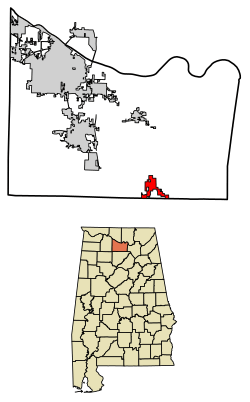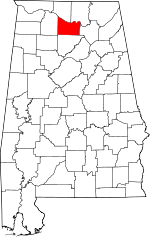Eva, Alabama
Eva is a town in Morgan County, Alabama, and is included in the Decatur Metropolitan Area, as well as the Huntsville-Decatur Combined Statistical Area. As of the 2010 census, the population of the town is 519, up from 491 in 2000. the mayor currently is Mayor Gary Livingston.
Eva, Alabama | |
|---|---|
 Location of Eva in Morgan County, Alabama. | |
| Coordinates: 34°19′30″N 86°44′51″W | |
| Country | United States |
| State | Alabama |
| County | Morgan |
| Area | |
| • Total | 4.18 sq mi (10.82 km2) |
| • Land | 4.15 sq mi (10.74 km2) |
| • Water | 0.03 sq mi (0.08 km2) |
| Elevation | 1,122 ft (342 m) |
| Population (2010) | |
| • Total | 519 |
| • Estimate (2019)[2] | 499 |
| • Density | 120.33/sq mi (46.46/km2) |
| Time zone | UTC-6 (Central (CST)) |
| • Summer (DST) | UTC-5 (CDT) |
| ZIP code | 35621 |
| Area code(s) | 256 |
| FIPS code | 01-24688 |
| GNIS feature ID | 0118060 |
History
Originally called Cowhead, the town began to be settled in 1820, just a year after Alabama achieved statehood.[3] William J. Rook began a Post Office in Cowhead in 1883; however, it was closed a month later. According to local lore, at a community meeting, the town received its current name Eva in October 1883 at the suggestion of a local physician, Dr. Lewis Keller, who had just delivered a beautiful baby girl by that name, Eva Brandon. He liked that name because like the girl, the town was just getting started. After discussion, the community agreed upon the name Eva because the town needed a new name as a prerequisite for establishing a new post office.[4] It was not until 1887 that the town's name was officially changed from Cowhead.[3]
In 1916, Mr. Wiley Steward, local saw mill owner, donated 5 acres of land to the town, for the construction of a new school. In 1918, using donations from the local community, Eva gazed with admiration upon a beautiful new four room schoolhouse. Nevertheless, as time went by, the need for higher educational training for the community was realized. In an effort spearheaded by local physician, Dr. J. G. Daves, later deemed, "the father of Eva School", in the 1920s a community campaign was set forth to raise the necessary funds to build another school. Even the Great Depression could not hold this thriving community down from its dream of higher education for its children.
It was a community undertaking, but the fairy tale dream of a resolute community was realized in 1930, when Eva became a proud possessor of an accredited high school and held graduation exercises with a senior class composed of three members.
The community forged ahead and in its desire to add to the curriculum of the school, through local donations, added a vocational agriculture building, elementary building, and in 1938, completed a large stone gymnasium. Eva School became a stunning campus with great educational opportunities provided to its students, through the vision of the community.
In 1972, with the opening of Albert P. Brewer High School in Florette, Eva High School was consolidated into this new east regional Morgan County High School facility.[4]
In 1996, the Morgan County Board of Education, through a capitol funds campus upgrade, demolished the old school buildings, excluding the gymnasium that was constructed in 1985 and old lunchroom building, constructed in the mid 1960s. The campus was rebuilt, with a beautiful new modern K-8 building. Today, Eva School, as it has done for a century, continues to serve as source of pride for the Eva Community.
Eva incorporated in 1963.[5]
Geography
Eva is located at 34°19′31″N 86°44′52″W (34.325209, -86.747722).[6]
According to the U.S. Census Bureau, the town has a total area of 2.9 square miles (7.5 km2), all land.
Demographics
| Historical population | |||
|---|---|---|---|
| Census | Pop. | %± | |
| 1970 | 146 | — | |
| 1980 | 185 | 26.7% | |
| 1990 | 438 | 136.8% | |
| 2000 | 491 | 12.1% | |
| 2010 | 519 | 5.7% | |
| Est. 2019 | 499 | [2] | −3.9% |
| U.S. Decennial Census[7] 2013 Estimate[8] | |||
As of the census[9] of 2000, there were 491 people, 194 households, and 152 families residing in the town. The population density was 168.0 people per square mile (64.9/km2). There were 213 housing units at an average density of 72.9 per square mile (28.2/km2). The racial makeup of the town was 98.37% White, 0.20% Native American, and 1.43% from two or more races. 0.41% of the population were Hispanic or Latino of any race.
There were 194 households, out of which 31.4% had children under the age of 18 living with them, 68.0% were married couples living together, 7.7% had a female householder with no husband present, and 21.6% were non-families. 18.6% of all households were made up of individuals, and 7.7% had someone living alone who was 65 years of age or older. The average household size was 2.53 and the average family size was 2.91.
In the town, the population was spread out, with 21.6% under the age of 18, 7.7% from 18 to 24, 29.9% from 25 to 44, 26.3% from 45 to 64, and 14.5% who were 65 years of age or older. The median age was 40 years. For every 100 females, there were 98.8 males. For every 100 females age 18 and over, there were 89.7 males.
The median income for a household in the town was $38,958, and the median income for a family was $45,781. Males had a median income of $32,159 versus $21,875 for females. The per capita income for the town was $19,069. About 7.2% of families and 6.7% of the population were below the poverty line, including 3.2% of those under age 18 and 13.2% of those age 65 or over.
Notable people
- Edsel Ford, poet
- Patrick McCauley, journalist, editor of The Huntsville Times from 1966 to 1994; interred at Eva Cemetery
References
- "2019 U.S. Gazetteer Files". United States Census Bureau. Retrieved June 29, 2020.
- "Population and Housing Unit Estimates". United States Census Bureau. May 24, 2020. Retrieved May 27, 2020.
- "Encyclopedia of Alabama". Encyclopedia of Alabama. Retrieved 2016-12-12.
- "Eva School -". Eva School. Retrieved 2016-12-12.
- http://www.encyclopediaofalabama.org/article/h-3497
- "US Gazetteer files: 2010, 2000, and 1990". United States Census Bureau. 2011-02-12. Retrieved 2011-04-23.
- "U.S. Decennial Census". Census.gov. Retrieved June 6, 2013.
- "Annual Estimates of the Resident Population: April 1, 2010 to July 1, 2013". Archived from the original on May 22, 2014. Retrieved June 3, 2014.
- "U.S. Census website". United States Census Bureau. Retrieved 2008-01-31.
